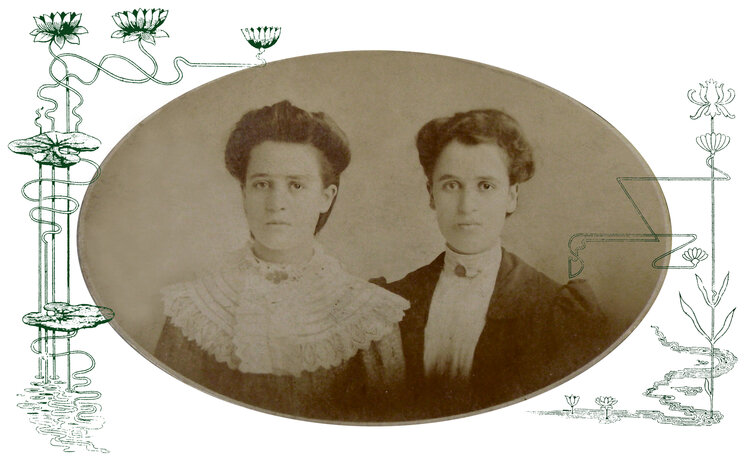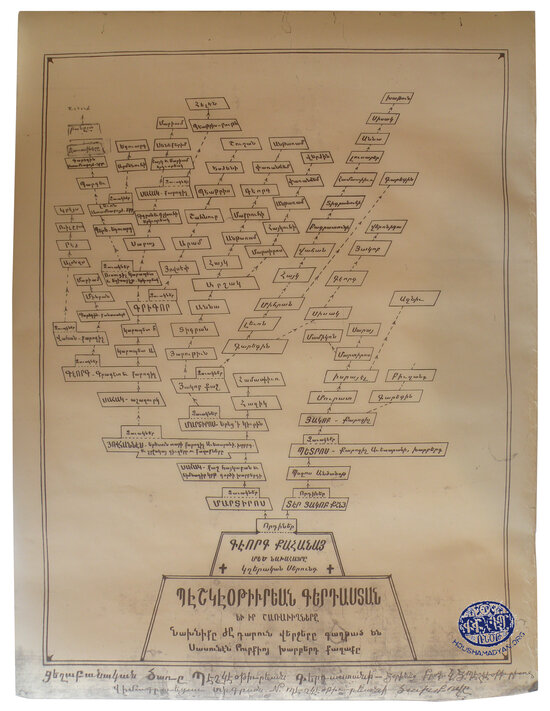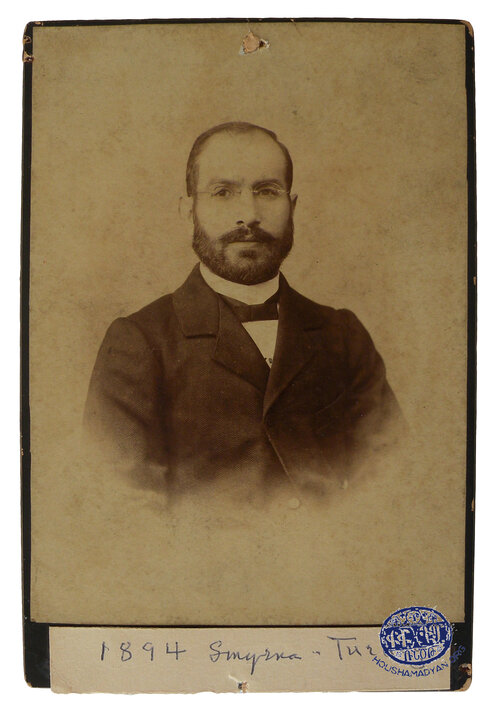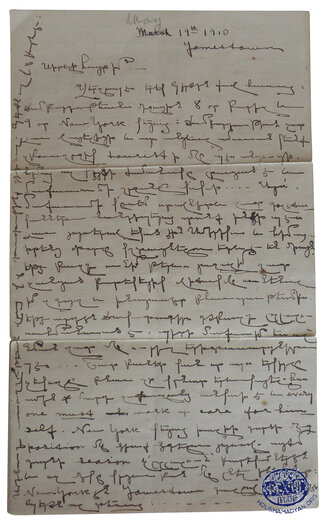Kasabach / Getoor collection - Southfield, MI, USA

This rich collection of photographs and documents is currently in the possession of Joan Kasabach Swain.
Joan’s maternal grandfather was Levon Beshgeotyourian (or Beshgetoorian, also known by the surname Getoor), he was born in Harput/Kharpert in 1888 and his family moved to Izmir/Smyrna in 1892 where they stayed till 1922, in other words till all the Armenians and Greeks of Izmir had immigrated. After 1922, Levon settled in the United States. Levon’s parents were: Garabed Beshgetoorian and Mariam Beshgetoorian. Levon had three brothers: Berj/Edward, Barkev and Karekin. In 1916, Levon married Elmon Chaderjian-Daghavarian in the States. They had two children: Edward/Yervant and Armenouhi (who was better known as Armen). Armen (1917-2007) is Joan Kasabach Swain’s mother, the one who put these archives at Houshamadyan’s disposal.
Joan’s father was Haroutyoun/Harry Kasabashian, who was born in 1912 in Shabin-Karahisar/Şebinkarahisar. Haroutyoun’s father was Yervant Kasabashian, who was born in Sivas/Sepasdia; he was a protestant reverend, he had graduated from the theological seminary of Merzifon/Marzvan. He had first served in Shabin-Karahisar (1906-1912) and later in Amasia (1912-1915). The Reverend fell victim to the Genocide. Haroutyoun’s mother was Arshalouys (or Arshalous), who was born in Sivas/Sepasdia, she was a graduate of the school in Merzifon.
Haroutyoun/Harry married Armen (Armenouhi) Beshgetoorian and the couple had two daughters - Marcia and Joan.
Kasabashian branch: Sivas/Sepasdia, Merzifon/Marzvan, Amasia, Shabin-Karahisar/Şebinkarahisar
Merzifon, 1906 - the graduates of the Theology branch of the “Anatolia College” and their teachers. Photograph by the Encababian brothers, Sivas. Standing first from the left in the third row, the person with the black moustache is Yervant Kasabashian, he is one of the graduates. In the back row, third from the right could be Rev. George Anastasiades, one of the teachers at the college.

1. Haroutyoun Efendi Kasabashian (Yervant’s father), photographed on his horse in Sivas/Sepasdia.
2. Merzifon/Marzvan, 1921 - after the end of WWI, Arshalous and her sons lived in Merzifon for a few years. Her husband Yervant had been killed in 1915. During these post-WWI years, Arshalous worked for the American Near East Relief founded in Merzifon.
The notes taken by Yervant and Arshalous (born Shahabian) Kasabashian on the back pages of the family Bible. This means that the Bible was in their family before the Genocide, and the family kept it after Yervant was killed and took it with them to the United States where Arshalous continued to write.
From these notes, we know the following about the Shahabian family:
- Arshalous’s father, Dikran Shahabian, was born in 1844 and died in 1911.
- Arshalous’s mother, Loucia Shahabian (born Shirinian), was born in 1858 and was killed during the Genocide.
- Dikran and Loucia Shahabian had two sons: Hovagim and Hrant, and two daughters: Arshalous and Dziadzan.
- Hovagim Shahabian was born in 1876 and died in the United States in 1949.
- Hrant Shahabian, was born in 1896, he was enlisted during WWI and died during the Genocide.
- Dziadzan Shahabian, was born in 1895 and died during the Genocide.
- Arshalous Shahabian, was born on 20/2 October, 1888 in Sivas/Sepasdia.
The following is written about the Kasabashian family:
- Haroutyoun A. Kasabashian (Yervant’s father), died on 18/31 October in 1909, in Sivas/Sepasdia.
- Yervant Kasabashian (Arshalous’s husband, Haroutyoun’s son) was born on 12/25. October 1880, in Sivas/Sepasdia. He was ordained a reverend in June 1914, at the “Anatolia College” in Merzifon/Marzvan. He was killed in July 1915 in Amasia, in the eve of the Genocide.
- [These lines are written by Yervant] “My daughter – Hreshdag [meaning Angel in Armenian] – was born on 16/29 January, 1909, on Friday at 2 o’clock and lived for 20 hours, she died on Saturday at 10 o’clock, in Shabin-Karahisar.
- “Vahram, my son, was born on 6 January, 1910, on Thursday at 12 o’clock, in Shabin-Karahisar.”
- “My son, Haroutyoun, was born on 2/15 February, 1912, on Thursday morning at 4 o’clock, in Shabin-Karahisar.”

1. A diploma from the all girls’ school of the “Anatolia College” in Merzifon/Marzvan. It belongs to Arshalous Shahabian (later Kasabashian) and is dated June 19, 1907. These are the signatures of the teachers: Charlotte R. Willard, Mary Ward, Claribel Platt, Myra Barns, Brabion Gyureghian, Makrouhi Azadian, and Sima Kouyoumjian.
2. Yervant H. Kasabashian’s diploma from the Theological seminary of Merzifon/Marzvan, 1906.
Before studying in Merzifon/Marzvan, Arshalous Shahabian (later Kasabashian) had studied at her native city Sivas/Sepasdia’s American college, from where she graduated in 1903. This is her diploma, which is dated July 6, 1903. Mary L. Graffam, Maritsa Delejian, Baydzar Papazian, and Hranoush Boyajian have all signed the diploma.
Yervant Kasabahsian’s mother, Yester (Haroutyoun’s wife). She was a survivor of the Genocide; we know that she took refuge in Syria. She wrote this postcard from Syria addressed to her son Haig who lived in the United States. Her other son, Yervant, had fallen victim to the Genocide. It’s written: “Is it getting cold or am I getting old?” on the photograph, probably written by Yester herself.

Beshgetoorian branch: Kharpert/Harput, Sivas/Sepasdia, Izmir/Smyrna

The Beshgetoorian family, Izmir/Smyrna, around 1890 – from left to right are: Edward/Berj (standing), Mariam (seated), Barkev (the little boy wearing white), Levon (the child sitting in front of Barkev), and Garabed. Their fourth child, Karekin, wasn’t born at the time. Photograph by Acropolis, Izmir, Armenian Street, no 51.

Garabed Beshgetoorian (1861-1941), photographed in 1894. Photograph by Zilpoche and Bukmedjian, Izmir, Rue des Roses 18.
Garabed was a graduate of the “Euphrates” college in the city of Harput. He has taught in Harput, Malatia, Sivas and Erzurum/Garin. In 1892, he was invited as a professor of Armenian and Armenian Literature to teach at the International College in Izmir, which belonged to the American Missionaries. Here he taught for 25 years. In 1921 or 1922 he immigrated to the United States and settled in Detroit, where he died in 1941.
He has worked for the following newspapers: Avedaper (Istanbul), Arevelian Mamoul (Izmir/Smyrna), Pyourag (Istanbul), Gochnag (New York/Boston), Baykar (Boston).

1. Levon Beshgetoorian (in the United States his surname would be transformed into Getoor) photographed in Izmir/Smyrna.
2. The Beshgetoorian brothers Levon (on the left) and Berj/Edward, photographed in Izmir/Smyrna. Both brothers would leave the Ottoman Empire before WWI. Levon (1888-1981) would go to Egypt, where he would stay for two years, then he would immigrate to the States via France; his brother Berj was already settled in the States. Levon would later study dentistry and become a dentist.

A letter written from Levon Beshgetoorian to his father Garabed Beshgetoorian, dated: June 20, 1920. Levon and his brother Berj had already settled in the States, and this letter was written in Detroit. Garabed Beshgetoorian’s brother Sahag and his family were also settled in Detroit. Levon had already married Elmon Chaderjian-Daghavarian and they had two children: Armen-Armenouhi (born in 1917) and Yervant (born in 1919).
We understand from the letter that the two brothers in the States were trying to get their family from Izmir to join them in the United States, Levon writes:
“You should sell everything as soon as possible, even if you lose money, and move here quickly. We don’t need the soil or the water of that cursed country. You are of a certain age now and from now onwards, there is only one pleasure in life – living a peaceful life surrounded by loved ones – especially when the four of us brothers are capable of taking care of you without any great sacrifices.”
This letter was written by Levon Beshgetoorian addressed to his father Garabed Beshgetoorian, who was in Izmir/Smyrna, the letter is dated: May 19, 1910. It was written from the city of Jamestown in the State of Virginia, USA. This is where Levon’s brother Berj had already settled.
We understand from the letter that Levon has reached the States, while his stay is Jamestown depends on whether there are job opportunities for him there. Levon gives details about his journey; he leaves Cairo on the 16th of April and reaches Port Said from where he takes a boat and goes to Marseille, from Marseille he takes a train and reaches Paris. Levon stays in Paris for 8 days; besides some sightseeing he meets some Beshgetoorian cousins. On the 29th of April, he takes a boat from the port of Havre, and heads for New York, where he reaches on the 10th of May.

This postcard/photo bears Hovhanness Chaderjian’s signature and is dated August 16, 1888. This is Elmon Chaderjian’s family; she was born in Sivas/Sepasdia. Elmon’s father, Aghayeg, had already left for the States in the 1890’s. In 1902, his family (including 10-year-old Elmon) joins him in the States and they live in Indianapolis. In 1916, Elmon marries Levon Beshgetoorian. Elmon is the maternal grandmother of Joan Kasabach Swain, the owner of this archival collection.
Even during the Ottoman Empire, some of the Chaderjians had changed their surnames to Daghavarian. Among these, the politician and physicist Nazaret Daghavarian, who was a member of the Ottoman parliament, he fell victim to the Genocide. Nazaret Daghavarian was born in Sivas/Sepasdia, he was Elmon’s paternal uncle.
Haygouhi Chaderjian and her husband (name unknown), Gesaria/Kayseri, probably 1892 – they are most probably related to Elmon Chaderjian (Levon Beshgetoorian’s wife).
On the back of the photo the following is written in Turkish using the Armenian alphabet: “From me to Nazaret Efendi Chaderjian, with happy memories, 92 [illegible], December 29, Gesaria/Kayseri, Haygouhi Chaderjian.”
Baptism certificate, belonged to Elmon Chaderjian, it is dated: December 1, 1891 and was issued in Sivas/Sepasdia. Elmon was the daughter of Aghayeg Chaderjian, she was baptized in the Cathedral (Holy Virgin) of Sivas by the priest Yeghishe. Her godfather was Garabed Frangyoulian. The certificate cost 1 kurush and has the stamp of the church council

Haig F. Kasabach collection:
The photographs in this section have been sent to us by Haig Kasabach. He is Joan Kasabach Swain's cousin. The photographs depic Haig's father Dr. Haig H. Kasabach.
The following brief family micro-history about Dr. Haig Haigouni Kasabach (Kassabashian)'s life was provided by Haig F. Kasabach.
Haig Haigouni Kasabach was the 7th of 8 children of Haroutoun and Yester (Esther) Kassabashian, my grandfather. Haig’s oldest brother was Yervant Kassabashian, who was the eldest child of Haroutoun and is Joan Kasabach Swain’s grandfather. Haig H. Kasabach was born in Sivas, Turkey in 1899 and died of a benign brain tumor on September 1, 1943 in New York City on the operating table. Doctors speculated that the tumor was caused by beatings from the Turks. Since he died when I was 7 years old, most of what I write here is from information I have obtained from others.
Haig is mentioned in the diary of Dr. Aristocles (George) Augustine, a Turkish Greek, who visited Amasia in June 1916 and met Haig and “relatives” (probably Arshalous). Aristocles returned to Amasia on March 1, 1917 and again visited with Haig. That night Haig had arranged a “musicale” at the governor’s home and both played and were able to attend a “feast” afterwards.
Joan Swain’s uncle (Haig’s nephew), Dr. Vahram Kasabach, wrote: “Haig was beaten to unconsciousness by the Turks and left for dead. After recovering consciousness, he made his way back to Sivas and found sanctuary with friends and former teachers of the American Missionary School, who nursed him through pneumonia induced by the rigors of his travel by night. When the Turks learned of his return, he made his way to Amasia the home of Arshalous, the widow of his eldest brother (Yervant). At the end of the war, he became a music teacher in Amasia, but wanted to further his education. In 1920, he immigrated to the US and briefly worked in New York before leaving for Ann Arbor, Michigan where he earned his way through the University of Michigan and graduated with honors from the medical school in 1926. He interned at the University Hospital and specialized in radiology. He came to the Presbyterian Hospital in New York in 1929 was a productive investigator. He was Assistant Professor of Radiology at Columbia University and a Fellow of the American College of Radiology.” During his brief career he discovered the “Kasabach-Merritt syndrome” with colleague Katharine Merritt.
In 1934, Haig married Erna Koerber and they had two children: Haig Frederick Kasabach and Arlynn Kasabach.























































